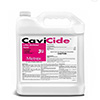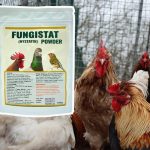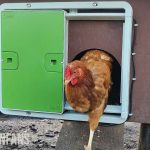Biosecurity for Chickens


Chicken Fans is reader-supported. When you buy through our links, we may earn a commission. Learn more about our privacy policy and disclaimer.
Chickens, and all domestic birds for that matter, are highly susceptible to pathogenic diseases. Keeping you, your family, and your flock safe starts with taking biosecurity measures in and around the chicken coop. By following simple steps, you can prevent (cross) contamination, which helps eliminate diseases.
Let’s find out the what and why about biosecurity in and around the chicken coop and how to take precautions.
What Is Biosecurity in Poultry Farming?
Biosecurity is the measures you take to protect your farm and the birds from all disease-causing organisms. A sound biosecurity system is a combination of different approaches which must be maintained at all times; a breach in one of the practices can compromise the entire system and nullify all the effort you have made. Disease transmission is almost inevitable in farms with little or no biosecurity enforced.
Good biosecurity starts with disinfecting work materials, shoes, and other items that have been in contact with chickens. We’ll start by addressing some high-quality, commonly used disinfectants to use on your farm or homestead.

Oxine
Sanitizer. Effective against a broad spectrum of bacteria
Bio-Cide International
BUY ON AMAZON

AMAZON
- CAVICIDE: Fill a trough with the CaviCide solution, place it outside the chicken coop and let any visitor dip their boots or shoes in the solution for at least two minutes. Use a spray bottle to disinfect work materials.
- OXINE: Activate the Oxine by mixing 3 1/4 fl. oz of Oxine and 10 grams of Bio-Cide Activator Crystals or food grade citric acid like white vinegar. Let the solution rest for five minutes and add one gallon of clean water. Always read instructions carefully.
Why Do You Need Biosecurity?
Good biosecurity protects your chickens and other birds from virulent organisms. Birds like broilers are very fragile; anything that will make them sick is better avoided. Disease prevention goes a long way in saving you money from frequent treatments. The absence of disease in your flock will help the layer birds reach their maximum egg-laying capacity and keep them happy and healthy.
The morbidity and mortality rate in a farm with good biosecurity measures is usually very low. Biosecurity helps in disease control and eradication.
Best Biosecurity Practices
Best biosecurity practices depend on many factors, such as the region where you are located, the type of poultry farm you run, and other factors.
Limit any health risks entering or exiting your chicken coop by following a few best practices:
1. Quarantine new birds

Never introduce a new bird to your flock without a minimum of 30 days of quarantine. The new bird may look healthy but could suffer from a disease in the incubation period, meaning there are no symptoms showing yet. By adding a sick bird to your flock, they’ll probably contaminate all other chickens, with serious consequences.
When it comes to the possible spread of diseases, it’s better to be safe than sorry and protect your existing flock by temporarily quarantining the new birds.
2. Clean equipment and supplies
Clean and disinfect all work materials used inside the coop or the chicken run. This includes shovels, brooms, rakes, dustpans and brushes, and wheelbarrows. If you’ve used any material in a high-risk environment, like other farms, poultry shows, or other places with live birds, thoroughly clean and disinfect all materials before using them. This way, potential disease carriers can’t access your chickens.
Clean and disinfect your chickens’ waterers and feeders once a week, and thoroughly clean the chicken coop once or twice a year.
We advise using Oxine Animal Health sanitizer to disinfect your materials and waterers/feeders. This product has been proven effective against various bacteria, fungi, and viruses, including E. coli, Salmonella, Staphylococcus, and more.
3. Apply Strict rules for visitors/workers
Reduce the number of visitations on your farm or at the chicken coop, if possible. If you’re expecting visitors, ensure they bring a pair of farm shoes they can use inside and around the chicken coop. Let them switch shoes before going home or going inside. Providing disposable shoe covers is another option.
Another great way to ensure your visitors won’t contaminate your chicken coop is to provide a foot dip at the entrance. All visitors can easily dip the bottom of their shoe in the solution for disinfecting and sanitizing. Ensure you use a solution that kills 100% of the pathogens. Cavicide has been proven very effective; every pathogen on a fomite that gets dipped into the water is instantly killed.
4. Avoid overstocking your farm
Overstocking your farm will lead to poor ventilation, and pathogenic organisms tend to thrive well in such environments. Ensure the stocking density is not exceeded.
5. Keep pets and rodents away
Rodents carry and transmit diseases and bacteria like Salmonella or Newcastle disease. These can endanger your flock, you, and your family. When dealing with a rat infestation in the chicken coop, rodents will not hesitate to visit your house looking for more food.
Prevention is easier than cure; you can efficiently keep rodents away by slightly adjusting your chickens’ feeding habits inside the chicken run and near your house. Keep their feed in closed containers, and don’t leave any feed or table scraps inside the run.

6. Change clothes/shoes
Use your chicken coop shoes solely for visiting the chicken coop. Don’t wear them inside the house or do groceries. If you’ve cleaned the chicken coop, change your clothes and wash your hands.
Use farm shoes or boots inside the chicken coop that are easy to clean and rinse off for your own ease. If you want to know our top farm boots, go to our ‘Best Farm Boots to Wear in the Chicken Coop‘.
7. Vaccinate
Immunizing your birds against endemic diseases is a good measure. If the virus or bacteria mistakenly find their way into your farm, you can rest assured that your birds are immune. Most diseases caused by these viruses and bacteria usually have high morbidity and mortality rate.
Chemical dips: This should be at the entrance of your farm. The water in the dip should be changed occasionally. The type of disinfectant you use at the dips goes a long way in the biosecurity practice; using a disinfectant that does not kill or denature on contact is as good as just having only a water pool. Ensure you use the type that kills 100% of the pathogens. Cavicide has been proven very effective. Every pathogen on a fomite that gets dipped into the water is instantly killed.
Types of Biosecurity
There are several types of biosecurity to be found:
- Conceptual Biosecurity
- Structural Biosecurity
- Procedural Biosecurity
1. Conceptual Biosecurity
Conceptual biosecurity measures have everything to do with the surroundings and environment of your farm or homestead. How close are you located to other farms, residential neighborhoods, or noisy environments?
The location of your house or chickens isn’t something that’s easily changed, but there are some things to keep in mind to create a safe environment for your flock so you don’t compromise biosecurity practices.

Noises near the coop
Birds don’t like (loud) noises. Survey the environment you want to site your farm or chicken coop for potential sources of noise. Or, if you’ve already installed your chicken run, check the noise level near the coop and think about relocating if the noises are too loud.
Studies show that noise causes a decrease in feed intake and makes the birds stressed. This may result in natural gut flora becoming virulent. Imagine when the noise is frequent and uncontrollable. This will make your birds miserable.
Proximity to other farms or homesteads
Having your farm or chicken coop close to other (small) farms can be a concern. When there is an outbreak in the neighboring farms, yours is already at a high risk of getting infected.
Proximity to residential areas
Diseases that can be transmitted from animals to humans and vice versa are a potential risk factor when keeping your chickens and farm animals close to a residential area. When keeping many chickens, you may want to consider relocating your farm to a more rural area.
Starting a farm on previous farmland
If you are starting your poultry farm or homestead where any animal farm once existed and by keeping biosecurity measures in mind, it is important to do some research to get the history of the former farm. This includes how long the farm existed, disease history, morbidity, and mortality figures, and why the farm was closed or relocated. This will be a guide to your decision on choosing that place.
2. Structural Biosecurity
Structural biosecurity deals with the structure of your farm or homestead and the surroundings. The entire construction plan of your farm contributes a huge part to the biosecurity measure. This includes the perimeter fencing, the length and width of the fence, drainage systems, the type of materials used for roofing and chicken run construction, and the flooring.
If you’re running a farm or homestead that allows visitors and/or employs staff, structural biosecurity also includes parking lots, changing rooms, and shower or toilet rooms.
Fencing and roofing
Free-ranging chickens in a suburban environment and biosecurity are not a good match, although foraging chickens are often happier. But if you want to ensure proper biosecurity in and around the chicken coop, keeping your chickens in a closed pen is best. Always keep in mind to provide plenty of space for your hens; check out our ‘Coop Size and Run Calculator‘ for the minimum space requirements.
The fencing of the chicken run should be high enough to protect the pen from the outside; it should also be sturdy to withstand the effects of heavy wind. Foresee only one entrance to the chicken run. The pen should be well-roofed or covered to avoid random visits by wild birds, which can be susceptible to many diseases.

Feed storage
Keep your chickens’ feed in closed containers so the feed doesn’t attract pests and predators. Keeping the feed storage area a rodent-free environment is key, as rodents serve as vectors for many diseases.
Visitors and workers
Parking spaces should be as far as possible from the pen to avoid the inhalation of hydrocarbon fumes by the birds and protect them from noises. Workers’ changing rooms and restrooms should be well-carved with good hygiene. Some zoonotic diseases emanate from this area.
3. Procedural Biosecurity
Procedural biosecurity is the routines or procedures followed to keep the biosecurity measures in place. Depending on their importance, these practices can be daily, weekly, or monthly tasks. Biosecurity procedures include changing shoes/clothes after visiting the chicken coop, disinfecting materials used inside the coop, quarantining new birds, hand hygiene, use of vaccination protocols, or using personal protective equipment if necessary.
Quarantine New Chickens
Never randomly introduce a new bird into the flock without placing the new bird into quarantine. Quarantine all new birds for a minimum of 30 days before introducing them to the others. By following this procedure, you’ll manage to spot possible diseases before the birds are introduced so they can’t contaminate the other chickens. You should immediately isolate suspected sick birds and dispose of any carcass as soon as possible.
Changing clothes and shoes

Don’t let visitors entering the chicken run wearing their own shoes; lend them yours, or provide disposable shoe covers. If you’re expecting many visitors, a foot dip is something to keep in mind. So visitors can sanitize their shoe soles by dipping them in the solution. Cavicide is a disinfectant that can be used in water as a foot dip. The chemical added to the water denatures the virulent pathogens from the car Tyres and footwear of individuals.
Provide farm shoes or boots solely used to enter the chicken coop. Change shoes after the chicken chores are done, and don’t leave them on to enter the house. Many chicken keepers make this a habit to prevent chicken poop on your Sunday shoes and to secure biosafety.
Disinfecting materials
The materials and working gear you’ve used inside the run and coop should be properly sanitized after use. We’re talking about shovels, rakes, brooms, wheelbarrows, dustpans, and brushes. Whatever you have used to clean the chicken coop or do some chores is best thoroughly cleaned after use. The same goes for waterers and feeders; give them a thorough clean every once in a while. At least once a week is recommended.
We advise using Oxine Animal Health sanitizer to disinfect your materials and waterers/feeders. This product has been proven to be effective against varieties of bacteria, fungi, and viruses, including E. coli, Salmonella, Staphylococcus, and more.
Vaccination protocols
You can follow vaccination protocols to ensure your birds are relatively immune. Vaccines are best to be administered by a veterinarian. Poultry birds are usually susceptible to some types of diseases, and depending on the type of diseases found in your region, you can determine the type of vaccine to give your birds.
Summary
Biosecurity in a chicken coop or near your chickens is important to prevent the spreading of disease, parasites, and other harmful organisms that can harm the chickens and reduce egg production. By implementing biosecurity measures such as disinfecting equipment, isolating new birds, and limiting visitor access, you can reduce the risk of disease transmission and maintain your flock’s overall health and well-being.

Dr. O. Ezenwafor is a licensed veterinarian with experience as a resident veterinarian in a poultry estate, having to vaccinate, diagnose and treat poultry diseases. She has worked on environmental samples and data collection for bacterial culture and isolation, such as Listeria monocytogenes, E.coli, salmonella, and staphylococcus aureus.






















